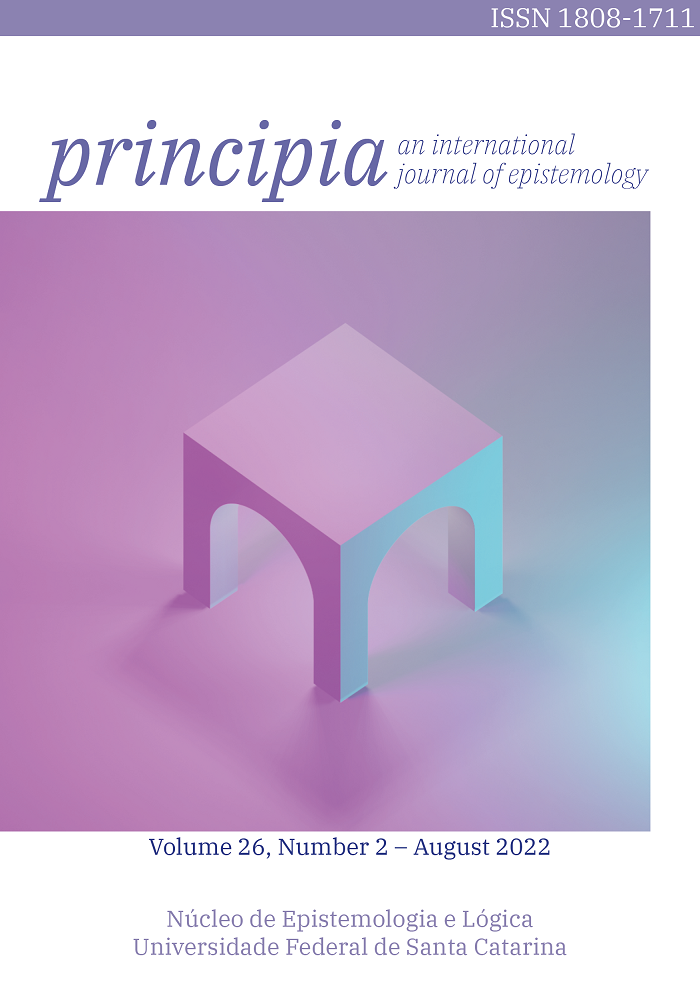An alternative View for Scientific Models Based on Metaphors: a case analysis from Darwin's use of metaphors
DOI:
https://doi.org/10.5007/1808-1711.2022.e84682Keywords:
Local realism, metaphor approach, Darwin’s models, deliberate distortions, powerful BeingAbstract
This paper aims to offer an alternative view for understanding scientific models based on metaphors. To accomplish this, we employ a special case of Darwin’s use of metaphors, such as the notion of powerful Being, in order to represent natural selection. Our proposal contributes to issues in the literature of scientific model, such as imprecisions in the understanding of scientific models, especially in models based on metaphors. Thus, our alternative view of models based on metaphors, and inspired by Darwin’s use of metaphors, provides us with four features, a-simplification and selection; b-articulation of familiar-unfamiliar structures; c-accessibility and moderations of complexity, and finally d-local realism. We contrast these features with Darwin’s use of a metaphors. We conclude by saying that our proposal of metaphor’s approach of models does not only contribute to the clarification of how these types of scientific models can be understood but it shows that metaphors can also contain a realist element that explains why scientists often use it in their practices of modeling the world.
References
Bailer-Jones, D. M. 2002a. Models, metaphors and analogies. In P. Machamer & M. Silberstein (eds.), The Blackwell guide to the philosophy of science, vol. 114. Malden, Massachusetts: Blackwell publishers.
Bailer-Jones, D. M. 2002b. Scientists' thoughts on scientific models. Perspectives on science 10(3): 275-301.
Bailer-Jones, D. M. 2009. Scientific models in philosophy of science. Pittsburgh: University of Pittsburgh Press.
Black, M. 1962. Models and Metaphors: Studies in language and Philosophy. Ithaca: Cornell University Press.
Carrillo, N. & Knuuttila, T. 2021. An Artifactual Perspective on Idealization: Constant Capacitance and the Hodgkin and Huxley Model. In A. Cassini & J. Redmond (eds.), Models and Idealizations in Science-Artifactual and Fictional Approaches, p. 51-70. Cham: Springer.
Cassini, A. & Redmond, J. 2021a. Introduction: Theories, Models, and Scientific Representations. In A. Cassini & J. Redmond (eds.), Models and Idealizations in Science: Artifactual and Fictional Approaches, p. 1-50. Cham: Springer.
Cassini, A. & Redmond, J. 2021b. Models and Idealizations in Science: Artifactual and Fictional Approaches. Cham: Springer.
Crow, J. F. 1987. Neutral Models of Molecular Evolution. In M. H. Nitecki & A. Hoffman (eds.), Neutral models in biology. Oxford: Oxford University Press.
Darwin, C. 2009 [1859]. The Origin of Species – By means of Natural Selection, or the preservation of favoured races in the struggle for life. 6th edition. Cambridge: Cambridge University Press.
Darwin, C. 2009 [1909]. The Foundation of the Origin of Species - Two Essays Written in 1842 and 1844 by Charles Darwin. Ed. by F. Darwin. Cambridge: Cambrigde University Press.
Darwin, C. April 1 1860. “Letter no. 2741” To F. J. Pictet de la Rive. Darwin Correspondence Project. https://www.darwinproject.ac.uk/letter/DCP-LETT-2741.xml. Access: 02.11.2021.
Delisle, R. G. 2019. Charles Darwin's Incomplete Revolution. Cham: Springer.
Fourez, G.; Rouanet, L. P.; Fourez, G. 1995. A construção das ciências. São Paulo: Editora da Unesp.
Frigg, R. & Hartmann, S. 2020. Models in Science. In E. N. Zalta (ed.), The Stanford Encyclopedia of Philosophy. Spring 2020 edition. https://plato.stanford.edu/archives/spr2020/entries/models-science/. Access: 02.11.2021.
García-Carpintero, M. 2021. Models as Hypostatizations: The Case of Supervaluationism in Semantics. In A. Cassini & J. Redmond (eds.), Models and Idealizations in Science – Artifactual and Fictional Approaches, p. 179-197. Cham: Springer.
Gerlee, P. & Lundh, T. 2016. Scientific models – Red Atoms, White Lies and Black Boxes in a Yellow Book. Cham: Springer.
Godfrey-Smith, P. 2009. Darwinian populations and natural selection. Oxford: Oxford University Press.
Henderson, L. 2017. Global versus local arguments for realism. In J. Saatsi (ed.), The Routledge handbook of scientific realism, p. 151-163. New York: Routledge.
Hesse, M. 1965. Models and analogies in science. British Journal for the Philosophy of Science 16(62): 161-163.
Hull, D. L. 1973. Darwin and his critics: The reception of Darwin's theory of evolution by the scientific community. Cambridge, Massachusetts: Harvard University Press.
Keller, E. F. 2002. Making sense of life: Explaining biological development with models, metaphors, and machines. Cambridge, Massachusetts: Harvard University Press.
Kimura, M. 1983. The neutral theory of molecular evolution. Cambridge: Cambridge University Press.
Laplane, L.; Mantovani, P.; Adolphs, R.; Chang, H.; Mantovani, A.; McFall-Ngai, M.; . . . Pradeu, T. 2019. Opinion: Why science needs philosophy. Proceedings of the National Academy of Sciences 116(10): 3948-3952.
Lewontin, R. C. 1985. Adaptation. In R. Levins & R. Lewontin (eds.), The dialectical biologist, p. 65-84). Cambridge, Massachusetts: Harvard University Press.
Mill, J. S. 1969 [1874]. Three essays on religion. New York: Greenwood Press.
Morgan, M. S. & Morrison, M. 1999. Models as Mediators: Perspectives on Natural and Social Science. Cambridge: Cambridge University Press.
Newton, I. 1973 [1686]. Sir Isaac Newton’s Mathematical Principles of Natural Philosophy and His System of the World. Trans. by A. Motte (1729) & F. Cajori. Berkeley and Los Angeles: University of California Press.
Odegard, D. 1964. Models and Metaphors: Studies in Language and Philosophy by Max Black. [Book Review of Models and Metaphors]. Philosophy 39(150): 349-356.
Okasha, S. 2019. Philosophy of biology – a very short introduction. Oxford: Oxford University Press.
Richards, R. J. & Ruse, M. 2016. Debating Darwin. Chicago: University of Chicago Press.
Ruse, M. 1999. The Darwinian revolution – science red in tooth and claw. 2nd edition. Chicago: University of Chicago Press.
Walton, K. L. 1993. Metaphor and prop oriented make-believe. European Journal of Philosophy 1(1): 39-56.
Wimsatt, W. C. 2007. Re-engineering philosophy for limited beings: Piecewise approximations to reality. Cambridge, Massachusetts: Harvard University Press.
Downloads
Published
Issue
Section
License
Copyright (c) 2022 Deivide Garcia da Silva Oliveira

This work is licensed under a Creative Commons Attribution-NonCommercial-NoDerivatives 4.0 International License.

Principia http://www.periodicos.ufsc.br/index.php/principia/index is licenced under a Creative Commons - Atribuição-Uso Não-Comercial-Não a obras derivadas 3.0 Unported.
Base available in www.periodicos.ufsc.br.



